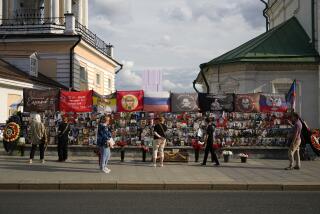Kalashnikov: Most popular, and deadliest, weapon of modern warfare
It killed more people in the 20th Century than the atomic bombs dropped on Hiroshima and Nagasaki.
The AK-47’s easy maintenance and light weight led to its becoming the armament of choice for at least 50 armies worldwide, as well as guerrilla factions, terrorist groups, drug gangs and pirates.
A symbol of resistance, revolution and independence, the rifle with the signature curved ammunition clip is celebrated on the flags of Mozambique and Lebanon’s Hezbollah militia.
The 1940s invention of what is now the world’s most ubiquitous weapon was attributed to Soviet military designer Mikhail Kalashnikov, who died Monday in Izhevsk, the Udmurtia Republic capital where the factory he ran produced about half of the estimated 100 million Kalashnikovs still waging war and terror the world over. Tens of millions have been manufactured elsewhere under contract with Russia, and millions more have been knocked off without license.
While the weapon is not particularly accurate, its chroniclers note, it is so easy to produce, maintain and clean that it can be reliably used by soldiers and militants anywhere. As ex-Marine and journalist C.J. Chivers says in his history of “The Gun,” it can easily be used by “the small-statured, the mechanically disinclined, the dimwitted and the untrained.”
“The AK has become the most famous rifle in world history,” said Adam Winkler, a UCLA law professor and author of “Gunfight: The Battle Over the Right to Bear Arms in America.”
“The rifle became popular first in the Cold War,” Winkler said. “These guns were cheap to manufacture, and the Russians made tens of millions of them and sent them to Warsaw Pact allies and Third World revolutionaries everywhere.”
Many of the Kalashnikovs produced for the 1970s and 1980s guerrilla movements backed by the Soviets against colonial and U.S.-aligned rulers have survived to arm insurgents spawned by the now-dormant proxy fights in Africa, Latin America and Asia.
Guns with the distinctive “banana clip” cartridge were carried by the Somali terrorists who attacked a mall in Nairobi, Kenya, in late September, killing more than 60 people. AK-47s have also been spotted in the hands of rebels fighting weak governments in Mali, Central African Republic and South Sudan.
The AK-47, which stands for “Avtomat Kalashnikov” and the year it went into production, was first assembled by then-24-year-old Kalashnikov in 1943, as he convalesced from an injury in the 1941 battle of Bryansk, where he had caught a glimpse of the Nazis’ superior firearms.
Chivers, in his book, contends the rifle was in fact “the output not of a man but of committees,” a collective accomplishment strangely attributed to the uneducated peasant that the Kremlin wanted to present as a hero instead of lauding the gun’s development as proof of the virtues of central planning.
Kalashnikov willingly took the credit throughout his long life, proudly recalling reports of wartime-era dictator Josef Stalin’s reaction when he was shown the first rifle.
“I was told that ... he took it in his hand and didn’t put it down while walking around his Kremlin office for the rest of the day,” Kalashnikov wrote in his memoirs, according to RIA Novosti in its report from Izhevsk.
In 2007, on the 60th anniversary of the rifle’s production, Russian President Vladimir Putin praised the Kalashnikov as “a symbol of the creative genius of our people.”
But eulogies to the inventor in Russian and foreign media alluded to both the global might projected by the AK-47 and its lethal influence on regional skirmishes and rogue attacks.
“His ingenuity earned him widespread admiration, but his legacy became more controversial when his weapons were used in some of the world’s bloodiest conflicts,” Russia Today said of the late inventor. As the rifle was “more and more commonly seen in the hands of terrorists, radicals and child soldiers, the inventor was often forced to defend himself to journalists.”
In interviews around the time of the 2007 commemorations, Kalashnikov deflected blame for the AK-47’s deadly impact from its Russian producers onto the world leaders waging armed conflict.
“Blame the Nazi Germans for making me become a gun designer,” Kalashnikov, son of Siberian peasants, told the Associated Press at the time. “I always wanted to construct agricultural machinery.”
As the AP observed it its obituary Monday, the world-changing invention of the soldier-turned-designer “sowed havoc instead of crops.”
Twitter: @cjwilliamslat
More to Read
Sign up for Essential California
The most important California stories and recommendations in your inbox every morning.
You may occasionally receive promotional content from the Los Angeles Times.











